Forum on Education of the American Physical Society
Fall 2007 Newsletter
Small Wonders
Christopher Chiaverina
When The Physics Teacher magazine editor, Karl Mamola, asked if I would like to edit a new column for the magazine that would, in Karl’s words, “be devoted to very brief contributions that describe all sorts of creative physics teaching ideas such as, but not limited to, simple experiments and demonstrations,” I jumped at the chance. Like most teachers of physics, I enjoy learning about and sharing unique approaches to physics teaching with others. I concurred with Karl’s suggestion that the column be called “Little Gems,” for the name reflects the fact that the activities were to be useful, engaging and to the point.
This fall will mark the beginning of the fourth year for Little Gems. Both Karl and I have been gratified by the number of truly creative experiments, demonstrations and teaching tips that have been submitted since the column’s inception. The teaching ideas, which have dealt with virtually every aspect of physics, have arrived from all over the world. In fact, the material for the very first column came from Spain.
Adolf Cortel, a frequent contributor to TPT, shared a remarkably simple method for demonstrating additive color mixing. As Figure 1 illustrates, different color stickers are attached to opposite sides of a black 3cm-x-3cm card. The card is fashioned into a simple turbine by bending opposite corners (Fig. 2). When the remaining corners are held between opposing fingers, the simple turbine is set spinning by blowing on the turbine’s fins.
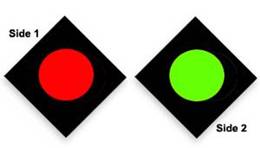
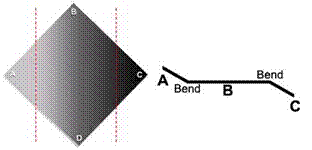
Figure 1 & Figure 2
The result: colors combine as light reflected from the stickers is presented to the eye in rapid succession. Due to persistence of vision, our retina retains an image for a short time after the source of light has come and gone. When a flash of light from a red sticker impinges on the retina, the sensitive cones that are activated by the light continue sending signals to the brain for a fraction of a second. If green light from the other sticker strikes the retina within this time, the brain will interpret the combination as yellow.
When yellow and blue stickers are used, white is perceived. The light reflected from the yellow sticker activates both the red and green sensitive cones, whereas the blue sensitive cones are activated by the light reflected from the blue sticker. The combined activity of the three color receptors is perceived as white.
Later that year, an extraordinary group of Japanese physics teachers known as the Stray Cats shared plans for what might be the world’s simplest motor. Consisting of a battery, rare earth magnet, wire, and nail, their version of a motor dating back to the days of Michael Faraday became an instant hit with the readers of TPT.


Figure 3 & 4
When the four components are assembled as shown in Fig. 3, the magnet sticks to the head of the nail and the tip of the magnetized nail is attracted to the ferromagnetic bottom of the battery. Holding one end of the wire to the top of the battery and touching the other end to the side of the magnet allows a current to flow through (and/or along the surface of) the magnet as shown in Fig. 4. The charge carriers moving in a magnetic field experience a Lorentz force. The resulting torque sets the magnet and nail spinning.
 Not long after the Stray Cat-inspired piece on the homopolar motor appeared in Gems, TPT readers offered a variety of new “spins” on the intriguing device. Dave Kagan jokingly said that he found it difficult to hold the battery, wire, nail and magnet assembly and proposed an arrangement that he claims requires less dexterity (see Fig. 5). Kagan’s upright homopolar motor consists of a spherical rare earth magnet perched on top a few coins, which in turn are supported by a battery.
Not long after the Stray Cat-inspired piece on the homopolar motor appeared in Gems, TPT readers offered a variety of new “spins” on the intriguing device. Dave Kagan jokingly said that he found it difficult to hold the battery, wire, nail and magnet assembly and proposed an arrangement that he claims requires less dexterity (see Fig. 5). Kagan’s upright homopolar motor consists of a spherical rare earth magnet perched on top a few coins, which in turn are supported by a battery.
But the homopolar story does not end here. In the February 2006 Gems column, Robert Beck Clark recounts how he used most of the same elements found in a homopolar motor to produce a generator. As shown in Fig. 6, he slid a rare earth ring magnet over the shaft of a nail. With the magnet snugly positioned next to the head of the nail, the assembly was placed in the adjustable chuck of a Dremel® tool. When the magnet was spun, a measurable emf (~23 mV) was produced between the outer edge of the spinning magnet and the shaft of the nail.
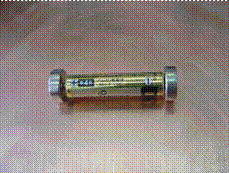

Figure 6 & 7
And leave it to the Stray Cats to come back with yet another ingenious device using rare earth magnets: a “motorcar” consisting of two rare earth magnets attached to the ends of a battery. When placed on a conducting sheet, the car is propelled by the electromagnetic force (Fig. 7).
Some Gems illustrate concepts that are simply out of this world. In their “Planets and Galaxies on Soap Films,” Alexsandro Jesus Ferreira de Oliveira and Eduardo de Campos Valadares presented a way to use droplets of water on the surface of soap films to simulate cosmic events. The capture of a satellite by a planet and the collision of galaxies with the formation of a new one with spiral arms are examples of phenomena that may be demonstrated with water and a little dishwashing liquid.
 In Fig. 8, two droplets of water on a soap film simulate the orbits of double stars. Water droplets on soap films also offer a unique way to visualize the distortion of the space-time due to the presence of a "large" mass, thus making general relativity more accessible.
In Fig. 8, two droplets of water on a soap film simulate the orbits of double stars. Water droplets on soap films also offer a unique way to visualize the distortion of the space-time due to the presence of a "large" mass, thus making general relativity more accessible.
Applying the philosophy of waste not, want not, Gordon Gore suggested a use for spent chemical light sticks (Little Gems March 2005). He found that even after the light-producing chemical reactions occurring in the light sticks had run their course, the residue in the sticks would fluoresce when exposed to ultraviolet light (see Fig. 9). The last we heard, Gordon was saving used light sticks for eventual use in a display.
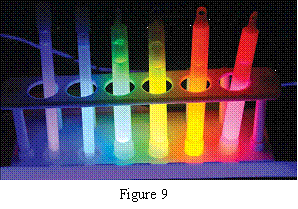
Students sometimes find projectile motion puzzling and need concrete evidence that the motion can be broken down into two independent components. In his March 2007 Gem, Bob Froehlich describes a simple and inexpensive device he uses to generate a parabolic trajectory of water droplets that, when frozen with a stroboscope, allows students to observe stop-action projectile motion from any vantage point (Fig.10). The apparatus consists of a standard doorbell around which latex tubing is wrapped. As water flows through the tubing, the clapper vibration causes water to be expelled through an eyedropper nozzle in droplets synchronized to twice the frequency of the exciting voltage.


Figure 10 & 11
The resulting droplet pattern can be upwardly angled to allow the students to observe not only the change in the separation between droplets in the y-direction but, with the aid of an overhead mirror, the constancy of the spacing between droplets in the x-direction (Fig. 11).
One consequence of diffraction is the limit it places on the eye’s ability to resolve the images of two closely spaced sources of light. If the overlap of the individual diffraction patterns is too great, the images will no longer appear distinct.
To demonstrate the eye’s limited resolving power, Deerfield High School physics teacher Diane Riendeau has her students produce pixilated images from dominoes (Little Gems, May 2007). Using templates created by Oberlin College professor Robert Bosch, students assemble images of Abraham Lincoln, the Mona Lisa, the Statue of Liberty and Martin Luther King (Fig 12).

Figure 12
According to the Rayleigh resolution criterion for a circular aperture, the human eye can just resolve images if the angular separation between objects is of the order of 10-4 radians. After producing their domino art, students apply this standard to predict the appropriate viewing distance.
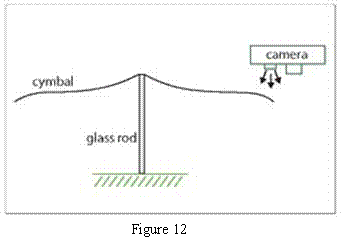
Sometimes the phenomena presented in Little Gems are a bit perplexing. Take for example the case of Antonio Serrano’s report of a cymbal being excited by a camera flash. He found that when a standard camera flash is set off a few centimeters from a cymbal or, for that matter, any metal plate with a high Q, the metal would ring (Fig. 13). Several readers have submitted possible explanations, but so far there is no consensus as to the cause of the ringing.
As you can see, the material submitted to Little Gems is both varied and fascinating. Do you have some novel phenomena or creative teaching ideas that you would like to share with the readers of The Physics Teacher magazine? If so, don’t delay. Write them up today!
Photo Credits
Figures 1 and 2 appear courtesy of Arbor Scientific, Ann Arbor, MI.
Figures 3 and 4: The Simplest Motor?, Reprinted with permission from Christopher Chiaverina, Phys. Teach. 42, 553 (2004), Copyright 2004, American Association of Physics Teachers
Figure 5: Upright Homopolar Motor, Printed with permission from David Kagan, Phys. Teach. 43, 68 (2005), Copyright 2005, American Association of Physics Teachers
Figure 6: The Simplest Generator from the Simplest Motor?, Reprinted with permission from Robert Beck Clark, Phys. Teach. 44, 121 (2006), Copyright 2006, American Association of Physics Teachers
Figure 7: The Homopolar Motor and Its Evolution , Reprinted with permission from Norihiro Sugimoto and Hideo Kawada Phys. Teach. 44, 313 (2006), Copyright 2006, American Association of Physics Teachers
Figure 8: Planets and Galaxies on Soap Films, Reprinted with permission from Alexsandro Jesus Ferreira de Oliveira and Eduardo de Campos Valadares, Phys. Teach. 44, 392 (2006), Copyright 2006, American Association of Physics Teachers
Figure 9: Black Light and Light Sticks, Reprinted with permission from Gordon R. Gore, Phys. Teach. 43, 184 (2005), Copyright 2005, American Association of Physics Teachers
Figures 10 and 11: Water Drop Pulser, Reprinted with permission from Robert J. Froehlich, Phys. Teach. 45, 183 (2007), Copyright 2007, American Association of Physics Teachers
Figure 12: Get to the Point…Quicker, Reprinted with permission from Diane Riendeau, Phys. Teach. 45, 313 (2007), Copyright 2007, American Association of Physics Teachers
Figure 13: Hearing a Camera Flash, Reprinted with permission from Antonio Serrano, Phys. Teach. 43, 309 (2005), Copyright 2005, American Association of Physics Teachers
Chris Chiaverina holds an M.S.Ed. in physics from Northern Illinois University. He recently retired from high school physics teaching after 34 years in the classroom. He spent the last decade of his teaching career at New Trier High School in Winnetka, IL where he served as director of The Connections Project, an initiative that employs interactive exhibits to demonstrate linkages among the arts, mathematics, and science. Chiaverina has written articles on physics education for a variety of journals, is co-author of four textbooks, and has served on the editorial board of The Physics Teacher magazine. In 1997, The American Association of Physics Teachers presented him with its Award for Excellence in Pre-College Physics Teaching. In 2002, Chiaverina served as President of the American Association of Physic Teachers. He is currently editor of Arbor Scientific’s CoolStuff online newsletter and The Physics Teacher magazine’s “Little Gems” column.